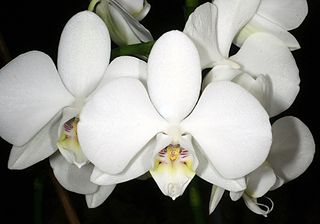
Phalaenopsis amabilis, commonly known as the moon orchid, moth orchid, or mariposa orchid, is a species of flowering plant in the orchid family Orchidaceae. It is widely cultivated as a decorative houseplant. It is an epiphytic or lithophytic herb with long, thick roots, between two and eight thick, fleshy leaves with their bases hiding the stem and nearly flat, white, long-lasting flowers on a branching flowering stem with up to ten flowers on each branch.
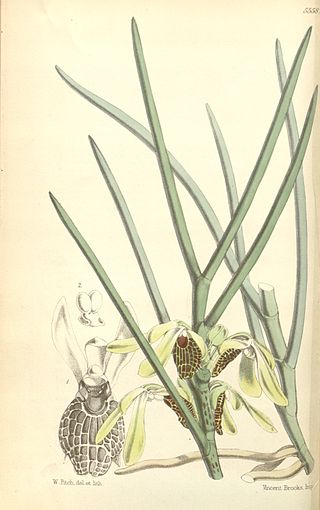
Luisia, commonly known as velvet orchids or 钗子股属 , is a genus of epiphytic or lithophytic orchids in family Orchidaceae. Plants in this genus have flattened roots, long leafy stems, narrow, thick, leathery leaves and short-lived flowers that open sporadically. There are about forty species found from tropical and subtropical Asia to the Western Pacific.
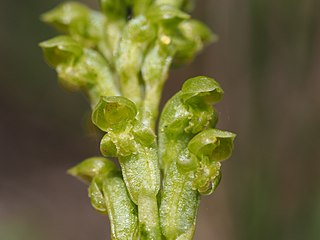
Microtis unifolia, commonly known as the common onion orchid, is a species of orchid occurring from south China to Japan, Malesia, and Australasia to the Southwest Pacific. It has a single green leaf and up to one hundred small green or yellowish-green flowers. A common, widespread orchid which is easily grown in pots and is sometimes a weed in plant nurseries.
Dendrobium rigidum, commonly known as the smooth tongue orchid or smooth tick orchid, is a species of orchid native to tropical North Queensland and to New Guinea. It is an epiphytic or lithophytic orchid with wiry, hanging stems, fleshy, dark green leaves and flowering stems with between two and seven crowded, cream-coloured, star-shaped flowers often with pink or red on the back. It grows on trees, shrubs and rocks in a paperbark swamps and rainforest.
Chiloschista phyllorhiza, commonly known as the white starfish orchid, is a species of leafless epiphytic or lithophytic orchid that forms small clumps with many radiating, flattened green roots. A large number of short-lived, crystalline white, star-shaped flowers with a yellow labellum are arranged along thin, arching flowering stems. It occurs in northern parts of Australia where it grows in rainforest, swamps and near streams.
Drymoanthus minutus, commonly known as green midget orchid, is a species of epiphytic or lithophytic orchid that forms small clumps with many thick roots emerging from a thin, erect stem. Between two and five dark green, leathery leaves are arranged along the stem and up to seven minute green to yellowish, star-shaped flowers are arranged on a stiff flowering stem. The sepals and petals are similar to each other and there is a fleshy white, unlobed labellum. This orchid occurs in northern Queensland where it grows in rainforest, usually at higher altitudes.

Micropera fasciculata, commonly known as the pale dismal orchid, is a species of epiphytic or lithophytic orchid with wiry stems forming large, tangled clumps. It has stiff, leathery leaves and flowering stems with between ten and twenty cream-coloured flowers with a white labellum. This orchid occurs in New Guinea, Queensland, the Solomon Islands and New Caledonia.

Robiquetia gracilistipes, commonly known as the large pouched orchid, is an epiphytic or lithophytic orchid from the family Orchidaceae that forms large, hanging, straggly clumps. It has long, thick, roots, a single stem, many thick, leathery leaves and up to forty cream-coloured, pale green or brownish flowers with red spots and a three-lobed labellum. It grows on trees and rocks in rainforest, usually in bright light. It is found in Malesia including New Guinea, the Solomon Islands and tropical North Queensland, Australia.

Robiquetia wassellii, commonly known as the green pouched orchid, is an epiphytic or lithophytic orchid from the family Orchidaceae. It has thick roots, a pendulous stem, between three and six crowded, dark green leaves and many crowded dark green flowers with pink to red centres and a white to yellowish labellum. It grows on trees and rocks in rainforest in tropical North Queensland, Australia.
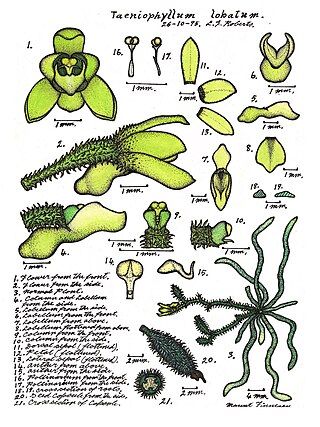
Taeniophyllum lobatum, commonly known as the yellow ribbonroot, is a species of leafless epiphytic or lithophytic orchid that forms small clumps. It has short stems, flattened pale to greyish green roots pressed against the substrate on which it is growing and usually two pale to bright yellow flowers. It only occurs in tropical North Queensland.

Taeniophyllum malianum, commonly known as the tangled ribbonroot, is a species of leafless epiphytic or lithophytic orchid that forms tangled clumps. It has flattened green roots with irregular white spots and pressed against the substrate on which it is growing. There are up to fifteen fragrant yellow, short-lived flowers with up to three open at the same time. It only occurs in tropical North Queensland and in New Guinea.

Thrixspermum congestum, commonly known as the cupped hairseed, is an epiphytic or lithophytic orchid that forms small clumps with many thin roots, up to fifteen leathery leaves and many star-shaped white or cream-coloured flowers. This orchid occurs from Papuasia to northern Australia.
Thrixspermum platystachys, commonly known as the starry hairseed, is an epiphytic or lithophytic orchid that forms untidy clumps with many tangled, wiry roots, up to ten stiff, leathery leaves and many star-shaped, cream-coloured flowers with an orange and white labellum. This orchid occurs from Papuasia to northern Queensland.
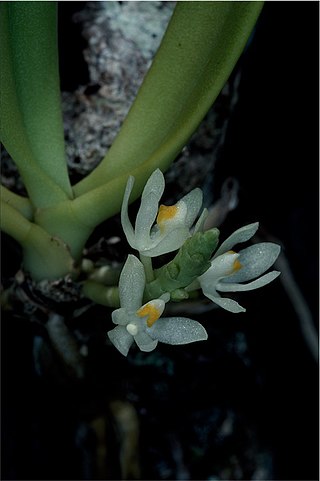
Trachoma speciosum, commonly known as the showy spectral orchid, is an epiphytic or lithophytic orchid that forms clumps with many thick, cord-like roots, between four and eight thick, leathery leaves and many short-lived, cream-coloured flowers with an orange and white labellum. This orchid occurs in tropical North Queensland.

Trachoma stellatum, commonly known as the starry spectral orchid, is an epiphytic or lithophytic clump-forming orchid with many thick roots. It has between three and eight thick, leathery leaves and many short-lived, cream-coloured flowers with purple markings and a yellow-tipped labellum. This orchid occurs in tropical North Queensland.

Trachoma papuanum, commonly known as the yellow spectral orchid, is an epiphytic or lithophytic clump-forming orchid with a between three and six thick, fleshy leaves and many dull yellow flowers with a white labellum opening in groups of up to four. This orchid occurs in New Guinea, Queensland and some islands in the South Pacific.
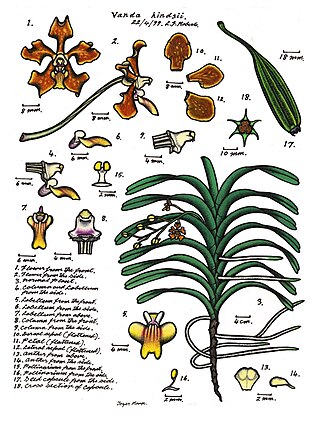
Vanda hindsii, commonly known as the native strap orchid or the Cape York vanda, is a large epiphytic or lithophytic clump-forming orchid. It has thick, white, cord-like roots, branching stems, many thick, leathery, strap-like leaves and between three and seven shiny brown flowers with greenish to yellow markings and a white labellum. This orchid occurs in New Guinea and tropical North Queensland.
Bryobium dischorense, commonly known as the spotted urchin orchid, is an epiphytic or lithophytic clump-forming orchid that has fleshy, oval pseudobulbs, each with a single thin leaf and between four and eight cup-shaped, cream-coloured or whitish flowers with red spots. This orchid occurs in New Guinea and Queensland.
Bryobium eriaeoides, commonly known as brittle urchin orchid, is an epiphytic or lithophytic clump-forming orchid that has fleshy, green pseudobulbs, each with two leaves and between three and twelve cup-shaped white to purplish flowers but that sometimes remain closed. This orchid occurs in New Guinea and Queensland.
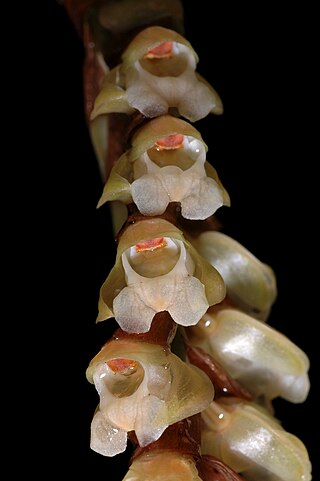
Pholidota imbricata, commonly known as the common rattlesnake orchid or necklace orchid, is a plant in the orchid family and is a clump-forming epiphyte or lithophyte with crowded pseudobulbs. Each pseudobulb has a single pleated, leathery leaf and up to sixty white, cream-coloured or greenish, cup-shaped flowers in two ranks along a wiry flowering stem. There is a large, papery bract at the base of each flower. This species is native to areas from tropical and subtropical Asia to the southwest Pacific.














